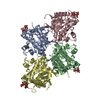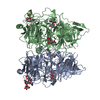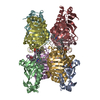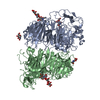+ Open data
Open data
- Basic information
Basic information
| Entry | Database: PDB / ID: 6i3n | ||||||
|---|---|---|---|---|---|---|---|
| Title | Helical MyD88 death domain filament | ||||||
 Components Components | Myeloid differentiation primary response protein MyD88 | ||||||
 Keywords Keywords | SIGNALING PROTEIN / helix / filament / TLR | ||||||
| Function / homology |  Function and homology information Function and homology informationregulation of chemokine (C-X-C motif) ligand 1 production / MyD88 deficiency (TLR5) / TIR domain binding / ATP-dependent histone chaperone activity / Toll binding / toll-like receptor 5 signaling pathway / induced systemic resistance / regulation of chemokine (C-X-C motif) ligand 2 production / neutrophil-mediated killing of bacterium / leukocyte activation involved in inflammatory response ...regulation of chemokine (C-X-C motif) ligand 1 production / MyD88 deficiency (TLR5) / TIR domain binding / ATP-dependent histone chaperone activity / Toll binding / toll-like receptor 5 signaling pathway / induced systemic resistance / regulation of chemokine (C-X-C motif) ligand 2 production / neutrophil-mediated killing of bacterium / leukocyte activation involved in inflammatory response / response to molecule of fungal origin / positive regulation of lymphocyte proliferation / response to peptidoglycan / toll-like receptor 8 signaling pathway / positive regulation of interleukin-23 production / regulation of neutrophil migration / establishment of endothelial intestinal barrier / IRAK4 deficiency (TLR5) / MyD88 dependent cascade initiated on endosome / TRAF6 mediated induction of NFkB and MAP kinases upon TLR7/8 or 9 activation / Toll-like receptor binding / cellular response to oxidised low-density lipoprotein particle stimulus / DEx/H-box helicases activate type I IFN and inflammatory cytokines production / MyD88 cascade initiated on plasma membrane / Toll signaling pathway / toll-like receptor TLR6:TLR2 signaling pathway / interleukin-33-mediated signaling pathway / neutrophil activation involved in immune response / microglia differentiation / RIP-mediated NFkB activation via ZBP1 / interleukin-1 receptor binding / MyD88 deficiency (TLR2/4) / positive regulation of cytokine production involved in inflammatory response / death receptor binding / interleukin-1-mediated signaling pathway / extrinsic component of cytoplasmic side of plasma membrane / IRAK4 deficiency (TLR2/4) / positive regulation of macrophage cytokine production / 3'-UTR-mediated mRNA stabilization / MyD88-dependent toll-like receptor signaling pathway / MyD88:MAL(TIRAP) cascade initiated on plasma membrane / extrinsic component of plasma membrane / toll-like receptor 4 signaling pathway / skin development / type I interferon-mediated signaling pathway / defense response to protozoan / response to amine / positive regulation of NLRP3 inflammasome complex assembly / positive regulation of interleukin-17 production / immunoglobulin mediated immune response / positive regulation of type I interferon production / immune system process / phagocytosis / response to amino acid / positive regulation of chemokine production / JNK cascade / signaling adaptor activity / positive regulation of smooth muscle cell proliferation / p75NTR recruits signalling complexes / TRAF6 mediated IRF7 activation in TLR7/8 or 9 signaling / response to interleukin-1 / lipopolysaccharide-mediated signaling pathway / positive regulation of interleukin-1 beta production / positive regulation of interleukin-8 production / positive regulation of JNK cascade / cellular response to mechanical stimulus / positive regulation of NF-kappaB transcription factor activity / positive regulation of interleukin-6 production / Interleukin-1 signaling / positive regulation of tumor necrosis factor production / PIP3 activates AKT signaling / cellular response to lipopolysaccharide / ER-Phagosome pathway / PI5P, PP2A and IER3 Regulate PI3K/AKT Signaling / regulation of inflammatory response / response to ethanol / defense response to virus / gene expression / molecular adaptor activity / cell surface receptor signaling pathway / positive regulation of canonical NF-kappaB signal transduction / endosome membrane / defense response to Gram-positive bacterium / defense response to bacterium / inflammatory response / innate immune response / apoptotic process / positive regulation of gene expression / cell surface / signal transduction / positive regulation of transcription by RNA polymerase II / protein-containing complex / identical protein binding / nucleus / plasma membrane / cytoplasm / cytosol Similarity search - Function | ||||||
| Biological species |  Homo sapiens (human) Homo sapiens (human) | ||||||
| Method | ELECTRON MICROSCOPY / helical reconstruction / cryo EM / Resolution: 3.1 Å | ||||||
 Authors Authors | Moncrieffe, M.C. / Bollschweiler, D. / Penczek, P.A.P. / Gay, N.J. | ||||||
 Citation Citation |  Journal: Structure / Year: 2020 Journal: Structure / Year: 2020Title: MyD88 Death-Domain Oligomerization Determines Myddosome Architecture: Implications for Toll-like Receptor Signaling. Authors: Martin C Moncrieffe / Daniel Bollschweiler / Bing Li / Pawel A Penczek / Lee Hopkins / Clare E Bryant / David Klenerman / Nicholas J Gay /   Abstract: Toll-like receptors (TLRs) are pivotal in triggering the innate immune response to pathogen infection. Ligand binding induces receptor dimerization which facilitates the recruitment of other post- ...Toll-like receptors (TLRs) are pivotal in triggering the innate immune response to pathogen infection. Ligand binding induces receptor dimerization which facilitates the recruitment of other post-receptor signal transducers into a complex signalosome, the Myddosome. Central to this process is Myeloid differentiation primary response 88 (MyD88), which is required by almost all TLRs, and signaling is thought to proceed via the stepwise, sequential assembly of individual components. Here, we show that the death domains of human MyD88 spontaneously and reversibly associate to form helical filaments in vitro. A 3.1-Å cryoelectron microscopy structure reveals that the architecture of the filament is identical to that of the 6:4 MyD88-IRAK4-IRAK2 hetero-oligomeric Myddosome. Additionally, the death domain of IRAK4 interacts with the filaments to reconstitute the non-stoichiometric 6:4 MyD88-IRAK4 complex. Together, these data suggest that intracellularly, the MyD88 scaffold may be pre-formed and poised for recruitment of IRAKs on receptor activation and TIR engagement. | ||||||
| History |
|
- Structure visualization
Structure visualization
| Movie |
 Movie viewer Movie viewer |
|---|---|
| Structure viewer | Molecule:  Molmil Molmil Jmol/JSmol Jmol/JSmol |
- Downloads & links
Downloads & links
- Download
Download
| PDBx/mmCIF format |  6i3n.cif.gz 6i3n.cif.gz | 242.1 KB | Display |  PDBx/mmCIF format PDBx/mmCIF format |
|---|---|---|---|---|
| PDB format |  pdb6i3n.ent.gz pdb6i3n.ent.gz | 194 KB | Display |  PDB format PDB format |
| PDBx/mmJSON format |  6i3n.json.gz 6i3n.json.gz | Tree view |  PDBx/mmJSON format PDBx/mmJSON format | |
| Others |  Other downloads Other downloads |
-Validation report
| Arichive directory |  https://data.pdbj.org/pub/pdb/validation_reports/i3/6i3n https://data.pdbj.org/pub/pdb/validation_reports/i3/6i3n ftp://data.pdbj.org/pub/pdb/validation_reports/i3/6i3n ftp://data.pdbj.org/pub/pdb/validation_reports/i3/6i3n | HTTPS FTP |
|---|
-Related structure data
| Related structure data |  4405MC M: map data used to model this data C: citing same article ( |
|---|---|
| Similar structure data |
- Links
Links
- Assembly
Assembly
| Deposited unit | 
|
|---|---|
| 1 |
|
- Components
Components
| #1: Protein | Mass: 17646.873 Da / Num. of mol.: 13 Source method: isolated from a genetically manipulated source Source: (gene. exp.)  Homo sapiens (human) / Gene: MYD88 / Production host: Homo sapiens (human) / Gene: MYD88 / Production host:  |
|---|
-Experimental details
-Experiment
| Experiment | Method: ELECTRON MICROSCOPY |
|---|---|
| EM experiment | Aggregation state: FILAMENT / 3D reconstruction method: helical reconstruction |
- Sample preparation
Sample preparation
| Component | Name: Human MyD88 / Type: COMPLEX / Entity ID: all / Source: RECOMBINANT | |||||||||||||||
|---|---|---|---|---|---|---|---|---|---|---|---|---|---|---|---|---|
| Source (natural) | Organism:  Homo sapiens (human) Homo sapiens (human) | |||||||||||||||
| Source (recombinant) | Organism:  | |||||||||||||||
| Buffer solution | pH: 8 | |||||||||||||||
| Buffer component |
| |||||||||||||||
| Specimen | Embedding applied: NO / Shadowing applied: NO / Staining applied: NO / Vitrification applied: YES | |||||||||||||||
| Specimen support | Grid material: COPPER / Grid type: Quantifoil R1.2/1.3 | |||||||||||||||
| Vitrification | Instrument: FEI VITROBOT MARK IV / Cryogen name: ETHANE / Humidity: 100 % / Chamber temperature: 277 K |
- Electron microscopy imaging
Electron microscopy imaging
| Experimental equipment |  Model: Titan Krios / Image courtesy: FEI Company |
|---|---|
| Microscopy | Model: FEI TITAN KRIOS |
| Electron gun | Electron source:  FIELD EMISSION GUN / Accelerating voltage: 300 kV / Illumination mode: FLOOD BEAM FIELD EMISSION GUN / Accelerating voltage: 300 kV / Illumination mode: FLOOD BEAM |
| Electron lens | Mode: BRIGHT FIELD / Nominal magnification: 75000 X / Nominal defocus max: 3100 nm / Nominal defocus min: 1000 nm / Calibrated defocus min: 900 nm / Calibrated defocus max: 3200 nm / Cs: 2.7 mm / C2 aperture diameter: 50 µm |
| Image recording | Electron dose: 0.92 e/Å2 / Detector mode: INTEGRATING / Film or detector model: FEI FALCON III (4k x 4k) |
- Processing
Processing
| Software | Name: PHENIX / Version: 1.14rc2_3191: / Classification: refinement | ||||||||||||||||||||||||||||||||||||||||
|---|---|---|---|---|---|---|---|---|---|---|---|---|---|---|---|---|---|---|---|---|---|---|---|---|---|---|---|---|---|---|---|---|---|---|---|---|---|---|---|---|---|
| EM software |
| ||||||||||||||||||||||||||||||||||||||||
| CTF correction | Type: PHASE FLIPPING AND AMPLITUDE CORRECTION | ||||||||||||||||||||||||||||||||||||||||
| Helical symmerty | Angular rotation/subunit: 98.01 ° / Axial rise/subunit: 5.98 Å / Axial symmetry: C1 | ||||||||||||||||||||||||||||||||||||||||
| 3D reconstruction | Resolution: 3.1 Å / Resolution method: FSC 0.143 CUT-OFF / Num. of particles: 1229488 / Symmetry type: HELICAL | ||||||||||||||||||||||||||||||||||||||||
| Atomic model building | Protocol: OTHER | ||||||||||||||||||||||||||||||||||||||||
| Atomic model building | PDB-ID: 3MOP Pdb chain-ID: A / Accession code: 3MOP / Source name: PDB / Type: experimental model |
 Movie
Movie Controller
Controller











 PDBj
PDBj











